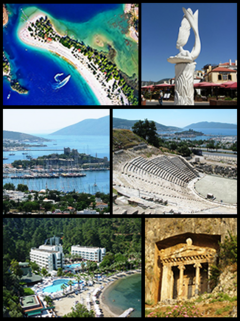Mugla
| Muğla | |
|---|---|
| Metropolitan municipality | |

Top left: Ölüdeniz, Top right: A sculpture in Marmaris, Middle left: Castle of St. Peter in Bodrum, Middle right: Halicarnassus Theatre, Bottom left: Otel Turunç, Bottom right: Tomb of Amyntas.
|
|
 Location of Muğla district within Muğla Province. |
|
| Location of Muğla district within Muğla Province. | |
| Coordinates: 37°13′N 28°22′E / 37.217°N 28.367°ECoordinates: 37°13′N 28°22′E / 37.217°N 28.367°E | |
| Country |
|
| Region | Aegean |
| Province | Muğla |
| First cited | In 2nd century BC under the indigenous name of Mobolla during its passage from a Carian federation linked with Taba (Tavas) to Rhodian domination. |
| Lycian or Carian to Menteşe Turkish period (14th century) | Cited as Mobolla with an intermediate form Mogolla attested later. |
| Turkish period (13th century) to the present | Cited as Muğla and a Menteşe urban center, after 1426 center of an Ottoman vilayet, after 1923 center of the homonymous province under the Turkish Republic |
| Municipalities | 5 |
| Government | |
| • Mayor | Osman Gürün (CHP) |
| Area | |
| • District | 1,660.55 km2 (641.14 sq mi) |
| Elevation | 660 m (2,170 ft) |
| Population (2012) | |
| • Urban | 64,706 |
| • District | 99,158 |
| • District density | 60/km2 (150/sq mi) |
| Time zone | EET (UTC+3) |
| • Summer (DST) | EEST (UTC+3) |
| Area code(s) | (+90) 252 |
| Licence plate | 48 |
| Website |
Muğla Municipality Governorship of Muğla |
Muğla (pronounced [ˈmuːɫa]) is a city in south-western Turkey. Before 1923 in the city 3000 Greeks were living and belonged to the district of Smyrna. Now, it is the center of the district the same name, as well as of Muğla Province, which stretches along Turkey's Aegean coast. Muğla center is situated inland at an altitude of 660 m and lies at a distance of about 30 km (19 mi) from the nearest seacoast in the Gulf of Gökova to its south-west. Muğla district area neighbors the district areas of Milas, Yatağan and Kavaklıdere to its north by north-west and those of Ula and Köyceğiz, all of whom are depending districts. Muğla is the administrative capital of a province that incorporates internationally well-known and popular tourist resorts such as Bodrum, Marmaris and Fethiye and also the smaller resort of Sarigerme
The district area's physical features are determined by several pot-shaped high plains abbreviated by mountains, of which the largest is the one where the city of Muğla is located and which is called under the same name (Muğla Plain). It is surrounded by slopes denuded of soil, paved with calcerous formations and a scrub cover which gives the immediate vicinity of Muğla a barren look uncharacteristic for its region. Arable land is restricted to valley bottoms.
A relatively small city of 61,550 (2009 estimates) and often overlooked by visitors to nearby coastal resorts, Muğla has received a new boost with the foundation of Muğla University in the 1990s. Today, the university brings together a student community of 16,000 and, added by its academia and staff, it played a key role in bringing movement to the city and in opening it to the outside world. Its former profile of a predominantly rural, difficult to access, isolated and underpopulated region enclosed with a rugged mountainous complex is now coming to an end. Also in recent years, a major program of restoration of the city's architectural heritage has enhanced local tourism. The city remains an orderly, compact and leafy provincial center which could keep its old neighborhoods without surrendering to a boom in concrete constructions and displays a progressist mind as exemplified by the pride still expressed on having had Turkey's first female provincial governor in the 1990s, Ms. Lale Aytaman. Nevertheless, Muğla still lacks sizeable manufacturing and processing centers and relies on trades, crafts, services, tourism and agriculture in its economy.
...
Wikipedia

